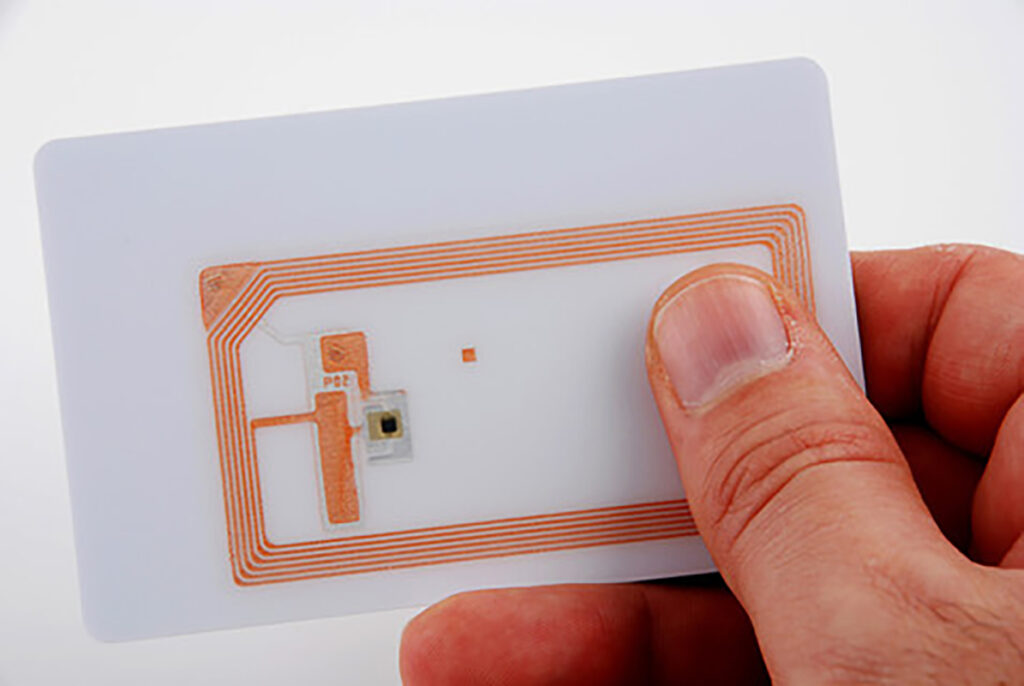1. RFID card introduction
RFID (Radio Frequency Identification) cards are a type of smart card that use radio waves to communicate with a reader. How to identify rfid card type? There are several types of RFID cards below, including:

Low Frequency (LF) RFID cards: These operate at a frequency of 125 kHz and have a short read range of up to 10 cm. They are commonly used for access control, time and attendance, and animal identification tags.
b. High Frequency (HF) RFID cards: These operate at a frequency of 13.56 MHz and have a read range of up to 1 dmeter. They are commonly used for contactless payment systems, identification and tracking of goods, and library management.
c. Ultra High Frequency (UHF) RFID cards: These operate at a frequency range of 860-960 MHz and have a read range of up to 10 meters. They are commonly used in logistics, supply chain management, and asset tracking.
d. Near Field Communication (NFC) cards: These are a type of HF RFID card that can also be used for communication between devices. They are commonly used for mobile payments, access control, and data transfer.
e. Active RFID cards: These contain a battery and can transmit data over longer distances than passive RFID cards. They are commonly used for tracking high-value assets and vehicles.
f. Passive RFID cards: These do not contain a battery and rely on the energy from the RFID reader to power the card and transmit data. They are commonly used for inventory management, asset tracking, and access control.
Passive RF tags use modulated scattering to send data. It must use the reader’s carrier to modulate its signal. This technique is suitable for access or traffic applications, as the reader can ensure that only a certain range of RF cards are activated. In the presence of an obstacle, with modulation scattering, the energy of the reader must come and go through the obstacle twice.
①According to the action distance can be divided into dense coupling card (action distance is less than 1 cm), near coupling card (action distance is less than 15 cm), sparse coupling card (action distance is less than 1 meter) and long distance card (action distance from 1 meter to 10 meters or even farther).
② According to the chip can be divided into read-only card, read and write card and CPU card.

2.How does rfid work?
RFID, or Radio Frequency Identification, is a technology that uses radio waves to automatically identify and track objects. The basic components of an RFID system include an RFID tag or transponder, an RFID reader or interrogator, and a backend system that processes the collected data.
The RFID tag consists of an antenna and a microchip that stores the object’s unique identification data. The tag is attached to the object, and the antenna receives signals from the RFID reader. When the tag receives a signal from the reader, it responds by transmitting its unique ID data back to the reader using the same radio frequency.
The RFID reader sends out a radio frequency signal to the tag, and when the tag responds with its unique ID data, the reader captures the data and sends it to the backend system for processing. The reader can capture the data from the
tag from a distance of a few centimeters up to several meters, depending on the frequency and power of the RFID system.
RFID technology is used in a wide range of applications, such as inventory management, supply chain management, access control, toll collection, and asset tracking.
3.The function of rfid cards
RFID (Radio Frequency Identification) cards are a type of contactless smart card that contain an embedded microchip and antenna that use radio waves to communicate with an RFID reader. The main function of RFID cards is to provide a quick and convenient way to identify and authenticate the user or the object that the card is attached to.
Some of the common functions of RFID cards include:
①Access Control: RFID cards are widely used for access control systems, such as door locks or security gates. When the user presents the card to the RFID reader, the reader sends a signal to the card, and the card responds with its unique identification data. The system then verifies the user’s identity and grants or denies access based on the pre-defined access rights.
②Payment: RFID cards are also used for contactless payment systems, such as credit cards, debit cards, or transit cards. The user can simply tap the card on the reader to complete the transaction without the need for a physical contact or signature.
③Tracking: RFID cards can be used to track and locate objects, such as luggage or inventory items. The RFID reader can scan the tags attached to the objects and provide real-time location data.
Identification: RFID cards can be used for identification and authentication purposes, such as employee ID badges or ④Passports. The card can store personal information and the reader can verify the authenticity of the card and the user’s identity.
⑤Overall, RFID cards offer a convenient and secure way to identify, authenticate, and track users and objects in various applications.
The advantages of RFID radio frequency card compare with contact IC card
1. High reliability
2. Good encryption performance
3. Prevent conflicts
4. easy to operate, fast
5. can be suitable for a variety of applications
Should you any inquiry, feel free to contact us. As we have more than 10 years experience manufacturer since 2012.



